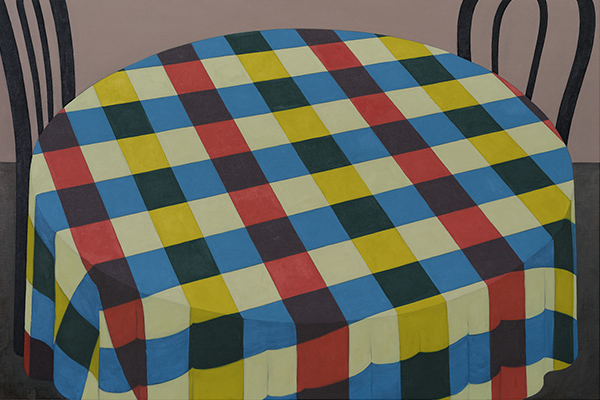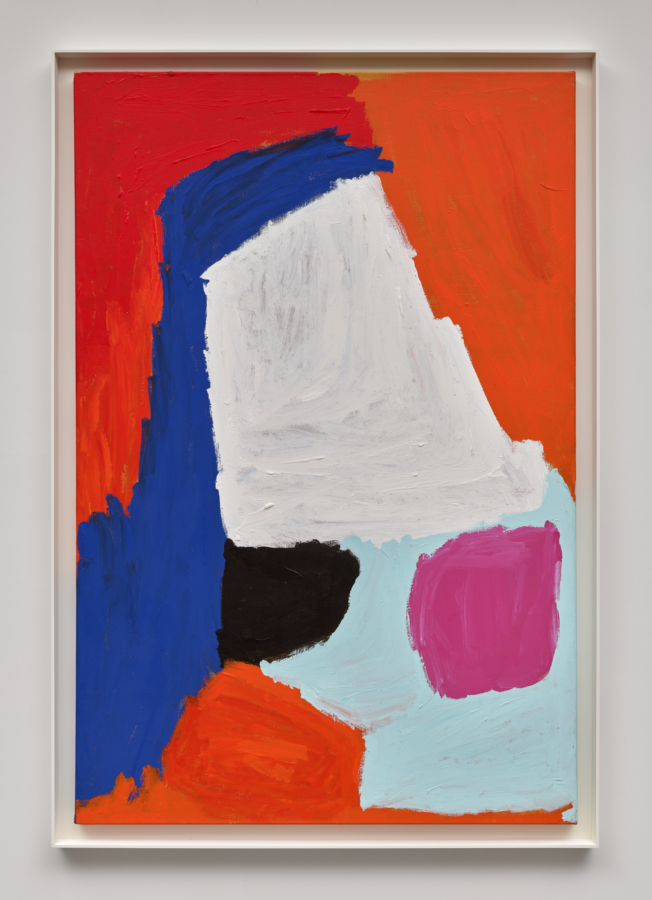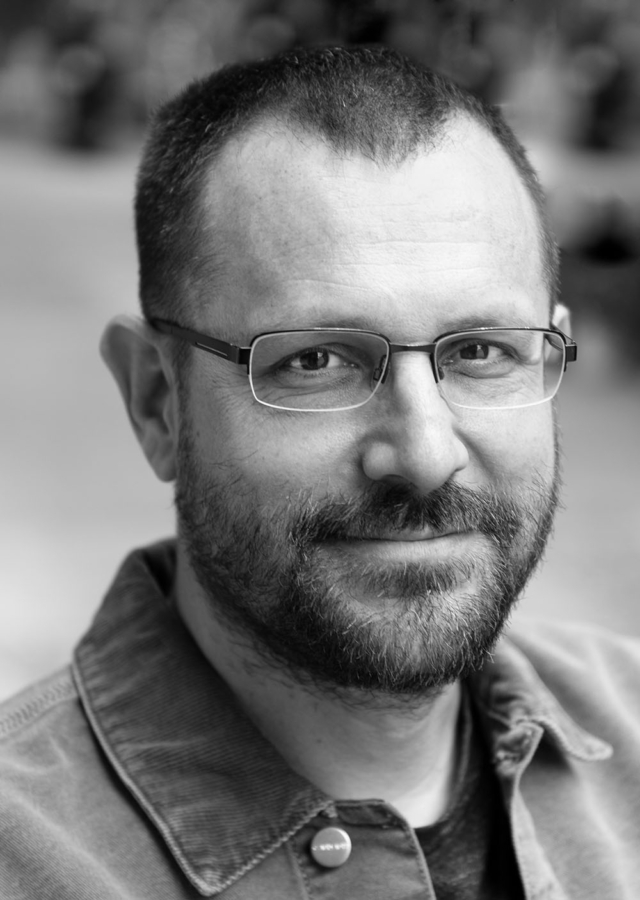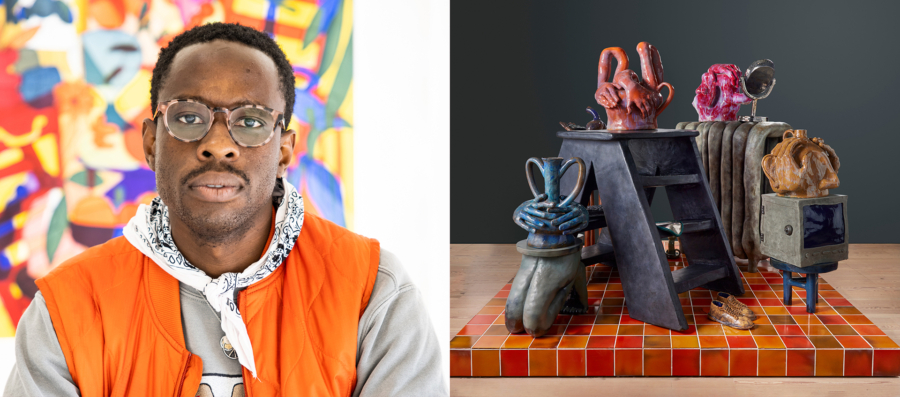Arts Magazine, December 1986.
The theory of Postmodernism suggests that our recognition of time has lost its depth. The overwhelming present of schizophrenic culture can no longer privilege the spirit of the new that was a hallmark of Modernism. In a culture whose main commodity is information, the artist’s impetus is no longer invention and production of the new, as it was in the industrial era, but instead an interminable reproduction. Demoted in this way, the new is not seen as originality but as the replication of what has preceded it.
The past fares no better in this reorientation of time. What might be called the “vertical” nature of narrative history, as it has long been practiced by society, has given way to a similar compression induced by informational overload which causes the flattening out of the past. What is left primarily—at least in relation to art—is the material residue of history recognized by the signs of each era’s characteristic style. The horizontal flow of historical styles removed from their deeper content thus enters the general complex of information, which in turn can be described visually as the transformation of the Modernist grid from a structure of (albeit shrinking) depth and spatialization into an ever-expanding electronic grid, whose conduits of information shoot across the shallow surface of semiconductor chips that link society together and direct the praxis of life. This is Postmodern culture today.
Of course, there has been a consequent effect on our subject, geometric abstract painting. In an article entitled “The Crisis in Geometry,” the painter Peter Halley declares: “Where once geometry provided a sign of stability, order, and proportion, today it offers an array of shifting signifieds and images of confinement and deterrence.
“The formalist project in geometry is discredited. It no longer seems possible to explore form as form (in the shape of geometry), as it did to the Constructivists and Neoplasticists, nor to empty geometric form of its signifying function, as the Minimalist proposed.”
Halley’s paintings will serve as the exemplary case of the Postmodernist’s theoretical revision of geometry. It is not that I find his paintings particularly interesting for their treatment of color or touch or of any other formalist concern with which the critic makes subjective judgments of excellence. What’s interesting about Halley’s work is the intellectual position of which the work is primarily illustration. And this is precisely the point. For this new geometric painting is not, say, about planar space or other formal issues, though it represents them. Instead, it is about an ideological space inherent in the Postmodern sensibility that does not produce an ethical alternative to the social spectacle of culture, but reproduces a spectacle that is generated by the culture itself.
Halley’s painting, Rectangular Cell with Conduit (1984), is a case in point. There would seem to be a direct link with the geometric schemes of Mondrian and, one might naturally presume, with the ethical project of Neoplasticism. Yet Halley does not see his geometry as an abstraction that might also convert the world to a new order. No, his painting shows the figural representation of a cell and a conduit— terms referring to the space engendered by the network of microchips, by the electronic grid of Postmodern society.
The collapse of abstraction into a figuration that simulates the abstract is a logical consequent of the theory propounded by Halley and others, according to which the contraction of contemporary culture allows no distance between categories of information, of style any longer. Yet what Biirger says about the loss of distance as an inability of art to criticize the praxis of life indicates that Halley’s simulation of purist abstraction in the form of a social instrument (the electronic cell) has closed that distance in the most ominous way. We saw, after the failures of Constructivism and de Stijl, the relinquishment of a politicized geometry. Now we see the relinquishment of geometry to the political.
It is impossible to read in this collapse of distance any irony. Irony depends on distance, on a cognitive apprehension of the difference between the condition of the thing that is ironic and the subject or object that makes the target of its irony. But when there is no space between categories of information, irony has no room to operate. And there is no sense of derision in Halley’s painting. He says simply that the design of Rectangular Cell with Conduit is based on the idea of an underground network of electronic transmission and the cell above to which it is linked.”
Indeed, what the image provides is a return to conventional narrative representation, but with one large qualifier—it claims that it has no real object from which it derives its image. Instead, its reduced schematic form simulates several things at once: earlier forms of abstract art and an earlier mode of representation (figurative narration), as well as an ideological content. Simulation is the preferred form for such artists as Halley who consider themselves responsible to describe a culture whose main product is “information, structured by automated data processing, [which] becomes a new kind of raw material—one that is not depleted by use.””
What the simulacrum offers is the schematized surface of another object, taken out of its former context, recontextualized and thus given another meaning. Jean Baudrillard, upon whose ideas of simulacra Halley traces his art, puts it this way: “Nothing separates one pole from the other, the initial from the terminal: there is just a sort of contraction into each other, a fantastic telescoping, a collapsing of the two traditional poles into one another: an IMPLOSION—an absorption of the radiating mode of causality, of the differential mode of determ nation, with its positive and negative elasticity—an implosion of mean- ing. This is where simulation begins.”™
Baudrillard and his follower Halley claim that in a society where the model can’t be distinguished from the original, everything becomes surface, everything can be treated interchangeably—as commodities are in capitalist culture. Thus there is no privilege given to the intention of any object—all objects are taken for their surface material signification as they continually shift contexts. Geometry is no longer employed to lend stability to the ethical precepts that lie within the same space of the canvas. Geometry is now contiguous with the ceaseless flow of information, which does not allow the geometric image or anything else to maintain its fixed point of origin. Halley can then claim that what he is doing, as he phrases it, is “hyperrealizing [objects}—in other words, taking themes that have a certain reality and sort of boosting them up into another reality. I’d like to use a couple of examples: if you take a glowing transcendental image in a Rothko, in my work that is replaced by day-glo. I also often say that I’ve taken Newman’s zip and made it into plumbing.”
Such talk suggests the kind of vivid materialization of concepts that follows the schizophrenic mode of Postmodernism. Yet Halley’s images are no less metaphorical than any other geometric art in their inability to enter the praxis of life. The only difference is that this art is entirely complicitous with the ethics of capitalism that now dominates social order.
As we see in another painting by Halley, Two Cells with Circulating Conduit (1985), this artist’s work chooses the path of least resistance. The painting is handsome enough. Its schematic elegance plays warm against cool colors, bright figures on a black ground. But the ideological content of this illustration of the electronic grid describes a totalizing system. There is no questioning, no distance, no critique, no irony … only hyperrealization, the mute surface substantiation of a political space. In other words, this work accepts the state of society as a form of representation in its own right that goes uncriticized. It claims no object previous to the “social circuit” of the microchip (no earlier model of geometry) nor does it deny its commodity function within the marketplace. Its complicity is a closed loop.
Halley’s painting describes two cells in a circularizing system, just as Baudrillard says, “The Circularization of power, knowledge and discourse brings every localization of instances and poles to an end.” The specific system within the electronic field that is the model of this circularizing enclosure is television. This is the medium in which the collapse of information is realized.
The ability to switch endlessly between channels of imagery and information causes the “fantastic telescoping” of ethics, of the relations between members of every society in the electronic miniaturization of world culture. In his essay, “The Eclipse of the Spectacle,” Jonathan Crary makes a logical connection between two forms of information transmission that work in the electronic grid: “According to the same axioms, television and the semiconductor operate by decomposing and remaking a field to achieve optimum patterns of circulation. Both intensify distribution flows while at the same time imposing intricate circuitries of control.”
The resulting image is one of passivity and entrapment. Stuck inside the cell of social order, mesmerized in front of the television monitor, which is now enlarged to enframe such other capital-oriented enter- prises as video and computer workstations, the TV and the semiconduc- tor alike represent seamless images of an electronically incarcerated society. In a recent song by Lou Reed, his lyrics “The currents rage deep inside us/This is the age of video violence,” take on special significance as the description of a penitentiary ordering of the social spectacle.
Halley has painted this very image, fascinated by the carceral structure of society as a kind of geometricization,” in a work called Yellow Prison with Orange Background (1985) from an ongoing series. Perhaps what is most striking is Halley’s acceptance of Baudrillard’s idea that this grid is total, that nothing falls through, breaks down, breaks through and maintains or recovers autonomy.”
This contemporary ethics, as in all ethics that have preceded it, is mediated not by the goal of the Good for every member of society, but for the class that dominates. So it is not surprising that Halley, whose reorientation of the geometric envisions the subservience of the grid to an imprisoning social condition, should say that he is most interested in reaching the “managerial class” that operates and main- tains the commodity-based grid of cells and conduits now in place.
It would still be possible to talk of this seemingly abstract art as critical of the dominant ethic, despite its self-proclaimed lack of dis- tance from the praxis of life, if it were not for the obvious elitism implicit in the making of the work. Though Halley has said that he wants to create art that anyone can make, I propose this caveat. In an art that is so conceptual, in which the image is so subservient to its informing ideology, the categorical imperative is not You must make, but You must think the making. The question to be asked is whether these highly intellectual notions of culture will filter down to the masses (or that society will be transformed) in so general a way that they become accessible and acceptable—so commonplace that anyone could think these works.
For the moment, this is not the case. The theoretical basis of this art, what might be called its fundamentally verbal rather than visual foundation, is too technical for general comprehension. Just because this art seems to accept the ethics of commodity capitalism and its allure of depthless, bright surfaces does not mean that it comes any closer to acceptance by general society. Remember the fate of Con- structivism. Instead, the fact is that these artists are talking to art consumers who either share the same vocabulary or who wish to buy into whatever is the newest art—that is to say, the newest art commodity. The success that this art has had among intellectuals and collectors probably does not pass beyond into less specialized realms of appreci- ation for any duration past its seeming novelty.
Of course, the very question of novelty raises a critical problem, for this art denies the possibility of the new. But this is a faulty conception because the work does claim an ideological difference from what has gone before. It is a new idea. And so it seems to return in a basic way to the humanistic aspiration of novelty and progress inherent in Modernism and the avant-garde.
So what one really hears are two voices speaking in Halley’s art. The first is the voice of the historical avant-garde, talking of the populace realizing the relevance of this art to society. The only shift here is that the artist doesn’t see his work as an instrument of ethical change but merely as a description, a simulacrum of capitalist ex- change. The other voice speaks softly, it is heard underneath the first— and this is the voice of the specialist who is addressing intellectual, conceptual, ideological concerns that finally maintain a distance. The populace at large can’t grasp this speech even when it is written down or painted because they do not have the leisure time to learn what is necessary to comprehend it.
This second voice identifies the historical condition of the artist as specialist and exile at the same time that it hands ethics back to what Halley calls the managerial class, which has the time and the power to formulate and enact the ethics that represent its interests. This new style of painting, called Neo-Geometric or just Neo-Geo, is no different in this regard than the geometric abstraction of de Stijl, which was only accepted by the class that could afford to convert it into a commodity.
I have not selected Peter Halley’s work because it is the only kind of geometric art being made today. As I have suggested already, there are many artists at work who don’t subscribe to the premises of Post- modernism, who go on in the face of what Postmodern society legislates and make art that seeks in geometric forms new expressions to order the chaos around them. Yet I have decided to end with Halley because his work does indeed present a vision of geometry unlike any other. And it represents an image of ethics, of the procession of the social spectacle, that has a darkness beneath its brilliant surfaces—an overly simplified yet fearful resemblance to the world that surrounds the picture plane.



